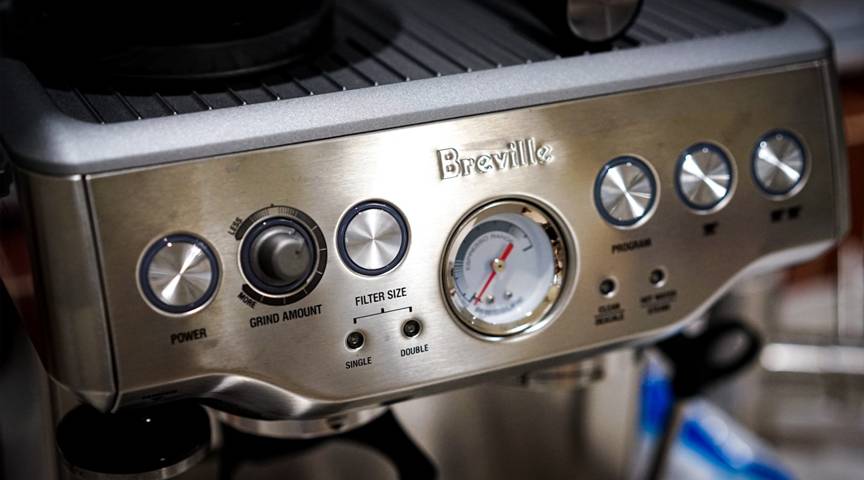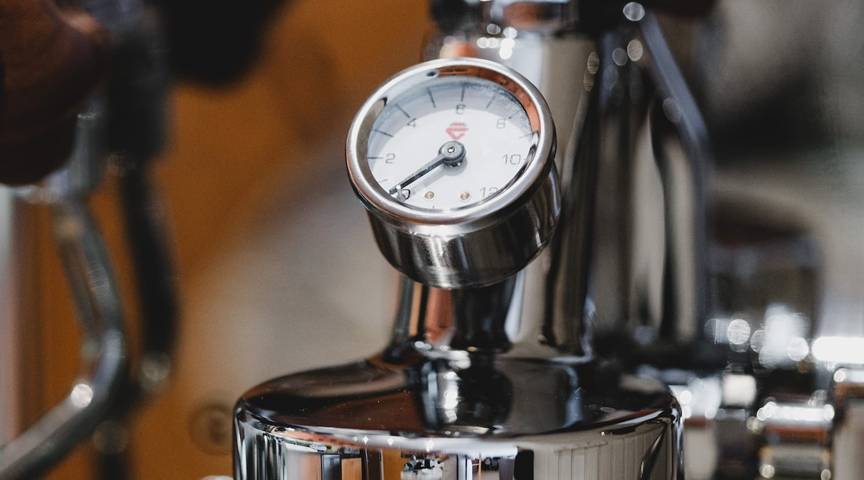There’s nothing better than a Breville coffee machine for getting barista quality coffees from the comfort of your own home – and without the hefty price tag to boot!
However, like any frequently used machine, these coffee makers do require regular maintenance to make sure they’re running optimally.
There’s nothing worse than looking forward to that morning cuppa and finding that the espresso machine pressure is too low.
This can be such a pain when it occurs, but it’s a fairly common problem with simple fixes. We’ll cover everything you need to get your machine pressure back to where it should be, including:
- Diagnosing the reasons behind low pressure in your Breville espresso machine
- A step-to-step guide to assessing machine pressure
- The common causes of pressure issues in Breville espresso machines
- Adjusting and optimizing pressure settings
- Preventative measures and routine maintenance tips.
Let’s dive right in!
Diagnosing Low Pressure in Your Breville Espresso Machine

If your espresso shots:
- Aren’t coming out tasting as delicious as they usually
- Are coming out extremely slowly (or not at all)
- Are water shooting through without picking up color
Then you may have a pressure issue. However, there are some basic things to check out first:
- Ensure your machine is plugged in and turned on
- Make sure the water tank is full to the line, and make sure there are no kinks in the tubing if you have a hooked-in machine
- Make sure to perform regular cleaning and maintenance of your machine.
If your machine seems okay but is still not performing properly, then it’s time to assume a pressure issue.
The Ideal Pressure for Perfect Espresso
Breville coffee machines generally extract the coffee grounds at two levels: an initial low-pressure extraction to ensure that the water flows evenly through the puck and doesn’t tunnel and a high-pressure extraction to get the most out of your coffee.
This first extraction is at around 2 to 3 bars, while the latter is at 9 bars.
Reaching optimal pressure is important for extracting all of the oils out of the ground coffee, which gives you rich flavor and picturesque crema on your shot.
If the pressure is a little too low, your shot won’t taste as good, and if it’s way too low your shot won’t extract at all!
Step-by-Step Guide to Assessing Your Machine’s Pressure
Checking the pressure of your Breville machine is extremely simple as they have built-in gauges! Look for the gauge on the front of your machine.
Understanding Your Breville’s Pressure Gauge
The pressure gauge starts at one and counts up in twos (1, 3, 5, 7, etc.). During the high-pressure extraction, the gauge should read between five and twelve, optimally hovering around nine.
On many machines, this range is labeled as “espresso range” on the gauge itself.
Common Causes of Pressure Issues in Breville Espresso Machines

There are a few different things that can cause pressure issues in Breville espresso machines.
One of the most common is having a blocked group head. The group head is what releases the water during the shot pour, and sometimes loose grounds can back up in the head and block it. Other problems that may cause pressure issues include:
- Incorrect amount of round coffee added
- Wrong grind size
- Poor tamping
- Clogged or faulty pump.
Blocked group head:
Blockage in the group head of a Breville espresso machine is the most common reason for low pressure.
During every espresso shot, the group head releases high-pressure water through the portafilter filled with fine ground.
So, chances are the ground can remain inside the group head and block it gradually. However, regular cleaning is the immediate solution to this issue.
Inaccurate amount of ground coffee:
Putting too much or too little amount of ground in a portafilter can cause low pressure too. The ground measurement should always be accurate for each espresso shot.
Wrong grind:
You will need a fine grind to have perfect espresso. Putting a coarse grind in a portafilter instead of a fine grind can immediately reduce the machine’s pressure. Too fine grind can also result in the same.
Insufficient tamping:
Tamping before extraction is an essential step to ensure an even flow of water. If you don’t tamp or do it incorrectly, it can also affect the espresso pressure.
Faulty pump:
Actually, the machine’s pump creates such high pressure of water. So, a pump with a technical fault can lead to low water pressure. The pressure can also be reduced in the case of a clogged pump.
Quick Fixes You Can Try at Home
Luckily, the majority of these issues can be resolved at home. Make sure you are regularly cleaning your machine to avoid blockages and do deep cleaning every so often to avoid major issues.
Measure your coffee carefully, use a fine grind, and make sure to tamp thoroughly and evenly.
Adjusting and Optimizing Pressure Settings
Many of these fixes can be carried out by adjusting the settings of the machine itself.
Check the grinder and ensure that it is set to fine-grind. Make sure to select the correct amount of ground coffee to fill the portafilter (usually it’s just between single and double).
If you suspect you have a settings issue, you can reset your coffee machine by holding down the program button until the machine beeps three times and then releasing the button.
This returns settings like temperature and shot volume back to default.
When to Seek Professional Help
If you’ve tried all of the maintenance and troubleshooting you can think of, you may have a faulty part!
You can contact Breville customer support from their website, where their experts can give you help and advice, order parts, or repair your machine if needed.
Read: Breville Serial Number Lookup
Preventative Measures and Routine Maintenance
As previously stated, the best way to avoid pressure problems is to keep up with routine maintenance of your machine.
This means that after every coffee, you should be wiping down the steam wand and performing a back flush (if your model supports this) at a minimum.
Many newer Breville machines have a built-in cleaning function which users are recommended to run at least once a week (and more often if you’re a heavy user).
You should also deep clean and descale your coffee machine around every six months to check for ongoing issues and prevent limescale build-up.
Conclusion
It’s crucial to have decent pressure on your Breville coffee machines if you want them to function optimally and produce the best-tasting shots of espresso.
When the pressure is too low, you could be left with a watery or bad cup of coffee – if you even get one at all!
Luckily, low pressure is a fairly common issue and one that’s usually easily fixable at home by checking a couple of settings and cleaning your machine.
If you keep up with regular cleaning and maintenance, it’s likely you won’t have to deal with low pressure anyway!
However, if something does happen that you can’t fix at home, it’s reassuring to know that Breville’s team is always there to help you out.
I hope this article helped to resolve any low-pressure issues you may be experiencing with your Breville espresso machine so that you can get back to making the perfect coffee!
Read: Breville Steam Wand Not Working – Why and Quick Fix